
Bread is a staple food prepared from a dough of flour and water, usually by baking. Throughout recorded history and around the world, it has been an important part of many cultures' diet. It is one of the oldest human-made foods, having been of significance since the dawn of agriculture, and plays an essential role in both religious rituals and secular culture.

Cake is a flour confection made from flour, sugar, and other ingredients and is usually baked. In their oldest forms, cakes were modifications of bread, but cakes now cover a wide range of preparations that can be simple or elaborate and which share features with desserts such as pastries, meringues, custards, and pies.
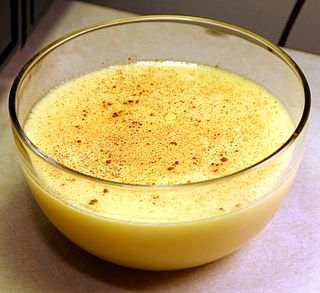
Custard is a variety of culinary preparations based on sweetened milk, cheese, or cream cooked with egg or egg yolk to thicken it, and sometimes also flour, corn starch, or gelatin. Depending on the recipe, custard may vary in consistency from a thin pouring sauce to the thick pastry cream used to fill éclairs. The most common custards are used in custard desserts or dessert sauces and typically include sugar and vanilla; however, savory custards are also found, e.g., in quiche.

Pastry is baked food made with a dough of flour, water, and shortening that may be savoury or sweetened. Sweetened pastries are often described as bakers' confectionery. The word "pastries" suggests many kinds of baked products made from ingredients such as flour, sugar, milk, butter, shortening, baking powder, and eggs. Small tarts and other sweet baked products are called pastries as a synecdoche. Common pastry dishes include pies, tarts, quiches, croissants, and pasties.

Porridge is a food made by heating or boiling ground, crushed or chopped starchy plants,

Halva is a type of confectionery originating from Persia and widely spread throughout the Middle East as well as South Asia. The name is used for a broad variety of recipes, generally a thick paste made from flour, butter, liquid oil, saffron, rosewater, milk, cocoa powder, and sweetened with sugar.
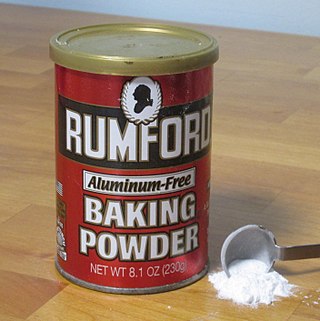
Baking powder is a dry chemical leavening agent, a mixture of a carbonate or bicarbonate and a weak acid. The base and acid are prevented from reacting prematurely by the inclusion of a buffer such as cornstarch. Baking powder is used to increase the volume and lighten the texture of baked goods. It works by releasing carbon dioxide gas into a batter or dough through an acid–base reaction, causing bubbles in the wet mixture to expand and thus leavening the mixture. The first single-acting baking powder was developed by food manufacturer Alfred Bird in England in 1843. The first double-acting baking powder, which releases some carbon dioxide when dampened and later releases more of the gas when heated by baking, was developed by Eben Norton Horsford in the U.S. in the 1860s.
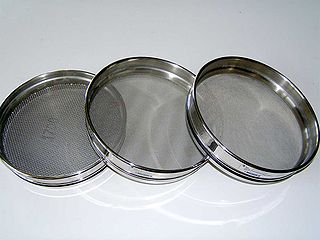
A sieve, fine mesh strainer, or sift, is a device for separating wanted elements from unwanted material or for controlling the particle size distribution of a sample, using a screen such as a woven mesh or net or perforated sheet material. The word sift derives from sieve.

Masa or masa de maíz is a maize dough that comes from ground nixtamalized corn. It is used for making corn tortillas, gorditas, tamales, pupusas, and many other Latin American dishes. It is dried and powdered into a flour form called masa harina. Masa is reconstituted from masa harina by mixing with water before use in cooking.

Gulab jamun is a sweet confectionary or dessert, originating in the Indian subcontinent and a type of mithai popular in India, Pakistan, Nepal, the Maldives, and Bangladesh, as well as Myanmar. It is also common in nations with substantial populations of people with South Asian heritage, such as Mauritius, Fiji, Gulf states, the Malay Peninsula, Great Britain, South Africa, and the Caribbean countries of Jamaica, Trinidad and Tobago, Guyana, and Suriname.

Yakimochi is grilled or broiled mochi or pounded rice cake. Traditionally, it is prepared using a small charcoal grill, but in modern times a gas grill can be used. During the time of the Autumn Moon, it is traditional to eat fresh yakimochi while sipping sake and enjoying the view of the full moon.
Fasting is very common among Jains and as a part of festivals. Most Jains fast at special times such as birthdays, anniversaries, during festivals, and on holy days. Paryushan is the most prominent festival, lasting eight days in Svetambara Jain tradition and ten days in Digambar Jain tradition during the monsoon. The monsoon is a time for Jains to observe most of the religious procedures. However, a Jain may fast at any time. Jain saints usually perform fasts every now and then but at times it becomes a compulsion for them when they have committed an error in relation to the preachings of Mahavira. Variations in fasts encourage Jains to do whatever they can to maintain whatever self control is possible for the individual. According to Jain texts, abstaining from the pleasures of the five senses such as sounds and dwelling in the self in deep concentration is fasting (upavāsa).

Arrowroot tea, also called kudzu tea, is a traditional East Asian tea made from East Asian arrowroot, a type of kudzu.
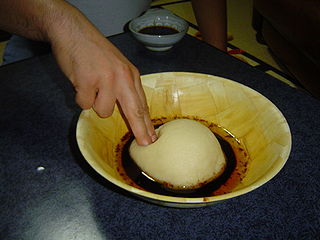
The cuisine of Libya is Arab and Mediterranean with Ottoman and Italian influence. One of the most popular Libyan dishes is bazin, an unleavened bread prepared with barley, water and salt. Bazin is prepared by boiling barley flour in water and then beating it to create a dough using a magraf, which is a unique stick designed for this purpose.

Chocolate gravy is a variety of gravy made with cocoa powder, sugar, butter and flour and is part of traditional Appalachian cuisine. It is most often served as a Sunday morning dish with fresh biscuits in the Ozark and Appalachian Mountain regions.
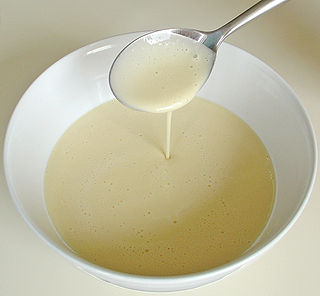
Batter is a flour mixture with liquid and other ingredients such as sugar, salt and leavening used for cooking. It usually contains more liquid than doughs, which are also mixtures of flour and liquid. Batters are usually a pourable consistency that cannot be kneaded. Batter is most often used for pancakes, light cakes, and as a coating for fried foods. It is also used for a variety of batter breads.

A powder is a dry, bulk solid composed of many very fine particles that may flow freely when shaken or tilted. Powders are a special sub-class of granular materials, although the terms powder and granular are sometimes used to distinguish separate classes of material. In particular, powders refer to those granular materials that have the finer grain sizes, and that therefore have a greater tendency to form clumps when flowing. Granulars refer to the coarser granular materials that do not tend to form clumps except when wet.
Brazil nut cake is a cake prepared using Brazil nuts as a primary ingredient. Coffeecake, shortcake, pound cake, fruitcake, brownies and torte cake may be prepared using Brazil nuts as a main ingredient. Ground or chopped Brazil nuts may be used. Brazil nut cake is a dish in Brazilian cuisine, and it is a common and popular cake in the Amazon region of Bolivia, Brazil and Peru.

Bazin (Arabic: البازين, pronounced, is an unleavened bread in the cuisine of Libya prepared with barley, water and salt. Bazin is prepared by boiling barley flour in water and then beating it to create a dough using a magraf, which is a unique stick designed for this purpose. The dough may then be placed in a pan and allowed time to harden, after which it is baked or steamed. The salt contributes to the hardness of the bazin. Bazin may have a paste-like and hardened texture. It may also be prepared using whole wheat flour, olive oil and pepper as ingredients.

















